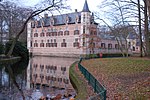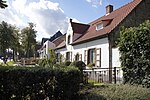Wilmarsdonk
Former municipalities of Antwerp ProvinceFormer populated places in BelgiumHistory of Antwerp

Wilmarsdonk was a village in Belgium, north of Antwerp, which has disappeared under the Port of Antwerp expansion. The village was first mentioned in 1155 and merged into the city of Antwerp in 1927. The village was sacrificed to the expansion of the harbor and destroyed in 1965. Only the church tower was preserved.
Excerpt from the Wikipedia article Wilmarsdonk (License: CC BY-SA 3.0, Authors, Images).Wilmarsdonk
Muisbroeklaan, Antwerp
Geographical coordinates (GPS) Address Nearby Places Show on map
Geographical coordinates (GPS)
| Latitude | Longitude |
|---|---|
| N 51.283333333333 ° | E 4.3666666666667 ° |
Address
Muisbroeklaan 482B
2030 Antwerp (Antwerp)
Antwerp, Belgium
Open on Google Maps







